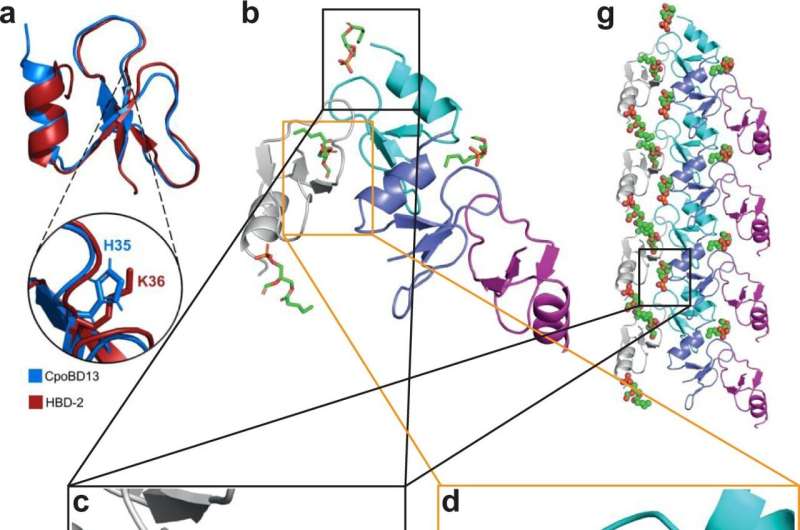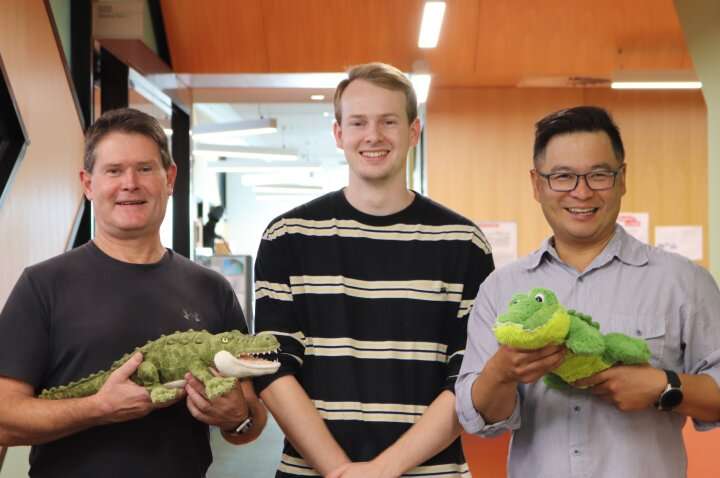This article has been reviewed according to Science X's editorial process and policies. Editors have highlighted the following attributes while ensuring the content's credibility:
fact-checked
peer-reviewed publication
trusted source
proofread
Crocodiles could save us from deadly infections

A new study by La Trobe University researchers reveals how crocodiles resist fatal fungal infections using a unique pH sensing mechanism despite living in filthy water.
Published in Nature Communications the research could be used to create targeted treatment for fungal infections in humans which are becoming increasingly frequent due to growing antibiotic resistance.
Lead author from La Trobe University, Scott Williams, focused on the crocodiles' defensins—small proteins that detect and announce an infection to the immune system.
"We solved structures of crocodile defensins and they look surprisingly like the same proteins in humans, which means we could use them as a template to treat fungal infections in humans," Scott Williams said.
"Crocodiles have great antifungal defenses and hopefully we'll be able to adapt their defense to our own needs."
Scott Williams said it's the first time this function has been found in any plant or animal.
"We haven't seen the pH sensing mechanism in any other animal or plant. The defensins are able to change their activity based on the pH environment, so we could engineer other defensins to turn off or on depending on the presence of infection," Scott Williams said.
"Some therapeutic treatments act on healthy cells by accident whereas this mechanism could help to reduce these off-target affects and focus on what's harmful."
Senior author Professor Mark Hulett said that the study is also the first to document the structure of the defensin membrane attack in high resolution.
"Using the power of the Australian Synchrotron, together with co-author Prof Marc Kvansakul, we were able generate structural data to define how defensins attack and kill fungal pathogens," Professor Hulett said.
"Consequently, our findings provide a model for understanding the anti-microbial activity of other defensins including those in humans."
For this study, Professor Hulett harvested the crocodile tissue with the help of John Lever and John McGrath from the Koorana Crocodile Farm in Yeppoon, Queensland, the first commercial crocodile farm in Australia.

Future therapeutics that could targeting infections
The findings of the study could allow researchers in the future to engineer defensins with pH-dependent activity in biotechnology and therapeutic applications, like treating serious infections in humans.
Saltwater crocodile defensin CpoBD13 harbors an intriguing antimicrobial activity dependent on environmental pH which is key to the body recognizing which area or cells are infected.
Based on the pH level of the cell's outer wall, CpoBD13 will recognize and attack fungal infections.
What are defensins?
Defensins are proteins in plants and animals that form an important part of our innate immune system to protect against infection by microbial pathogens such as bacteria, fungus and viruses.
They were first discovered in the 1980s and more recently have been attracting attention as potential therapeutics for the treatment infectious disease and cancer.
Although most research effort has focused on human and plant defensins, very little is known about defensins from other species that could harbor unique and useful functions.
The Hulett Lab at La Trobe University is leading research to understand the function of plant and animal defensins towards their application as novel therapeutics for treating human disease.
More information: Scott A. Williams et al, Crocodile defensin (CpoBD13) antifungal activity via pH-dependent phospholipid targeting and membrane disruption, Nature Communications (2023). DOI: 10.1038/s41467-023-36280-y
Journal information: Nature Communications
Provided by La Trobe University




















